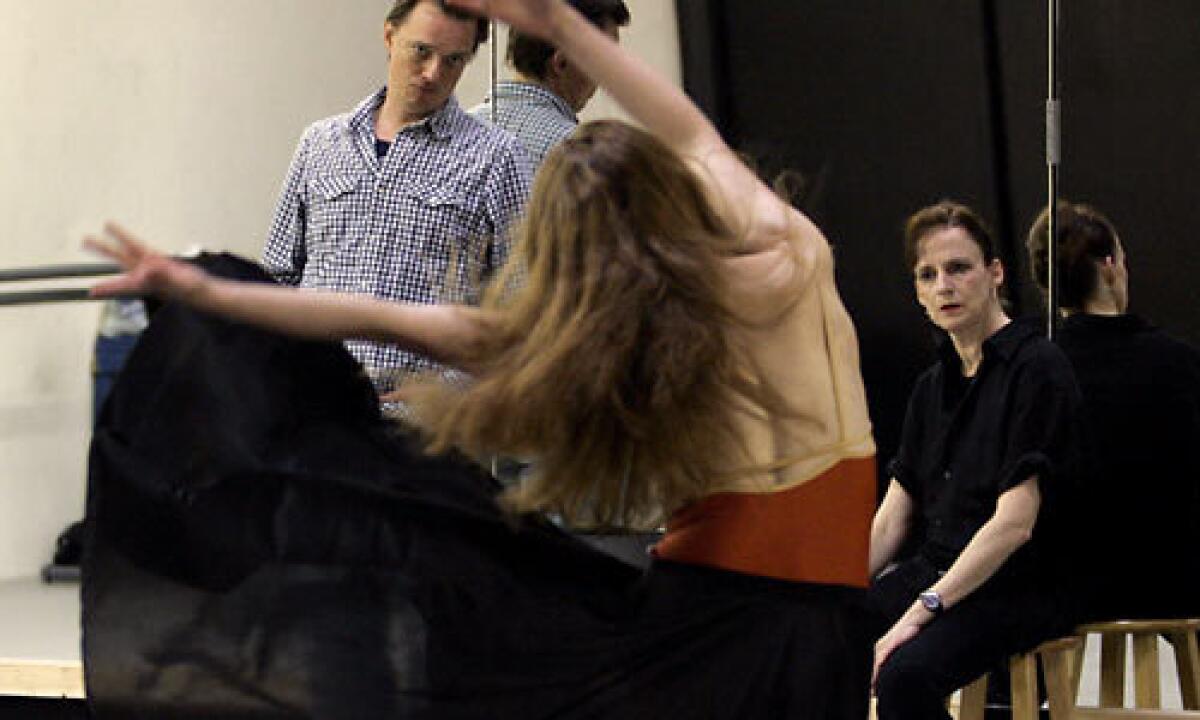Los Angeles Ballet meets ‘The Evangelist’

In a warehouse space on a no-frills Westside industrial street, Thordal Christensen, co-artistic director of Los Angeles Ballet, points to a rickety little table.
“Welcome to my office,” he jokes. “We’ve been in here four months, so it’s still a work in progress.”
The unfinished but spacious digs are another step forward for 2-year-old LAB, the city’s latest hope for home-based premier classical ballet.
Half of the interior is a jumble of racks of costumes, stacks of Marley flooring -- a special sprung surface carted to venues for the dancers’ use -- and utilitarian furniture.
But in the expansive, mirrored studio space on the other side of a partition, with loading dock doors rolled open for ventilation, several of the company’s 26 young dancers are warming up in motley practice gear.
Christensen and Colleen Neary, his wife and fellow artistic director, are about to revisit a work that was choreographed for them 16 years ago: “The Evangelist,” a spiritual duet inspired by 1920s charismatic preacher Aimee Semple McPherson, set to the music of Charles Ives.
It will tour to four venues in April and May, beginning Friday and Saturday at UCLA’s Freud Playhouse, as part of a varied program that includes “he said/she said,” a world premiere by Jennifer Backhaus of the Orange County-based Backhausdance; George Balanchine’s “Allegro Brillante”; and August Bournonville’s “Napoli/Pas de Six” and “Tarantella.” Balanchine’s “Who Cares?” will replace the Bournonville pieces for the company’s Irvine Barclay Theatre performance May 17. Appearing with the company as guest artist will be Orlando Ballet’s Eddy Tovar.
‘The Evangelist’
Created by choreographer Lar Lubovitch when Christensen and Neary were principals with Pacific Northwest Ballet, “The Evangelist” was the critical highlight of Lubovitch’s ballet “American Gesture” at its 1992 Kennedy Center premiere. A meld of classical form and Grahamesque force, it depicts a male penitent’s struggle toward redemption, guided by a powerful female figure.
“It’s always nice to work on something that you’ve done yourself,” Christensen says. “At the same time, you have to make sure it becomes the dancer’s piece, because it’s really about getting them to find . . . “
“Themselves in it,” interjects Neary.
“And the spirit of the piece,” Christensen finishes.
For the next 30 minutes, the couple, dancer-fit themselves, take to the floor by turns to demonstrate a lift or position, coaching the pairs who will alternate in the work (and wear Christensen and Neary’s original costumes): Peter Snow and Melissa Barak, and Andrew Brader and Kelly Ann Sloan.
The intensity of emotion the dancers must express in arching bends and high lifts, extreme gestures and moments of muscular rigidity is clear when they take a break, panting and dripping with sweat.
Christensen and Neary next take five couples through Balanchine’s demanding and lyrical “Allegro Brillante,” set to Tchaikovsky, correcting a step here, a line there.
“We call it a dancer’s ballet,” Neary says later, “because dancers love to do it. It’s a full-length ballet in 17 minutes -- there are that many steps.”
“Is it fun, or is it death?” Neary asks the breathless company when rehearsal ends. The consensus: “It’s fun.”
Taking the next step
With their international careers as dancers behind them, Christensen, former artistic director of the Royal Danish Ballet, and Neary, a New York City Ballet alumna and authoritative Balanchine choreographer, say they don’t mind being out of the spotlight. “When you’re onstage, it’s such an incredible feeling, but being offstage and seeing somebody else do what you’re giving them is even more fulfilling,” Neary says.
Dancing is a short-lived career, Christensen adds, “and we’re fortunate to have the opportunity to give it to the next generation.”
New work is key to the growth of Los Angeles Ballet, he says. The company launched with a familiar repertoire that included Balanchine masterworks and its own “Nutcracker” in order to “excite the audience and create a company style. Now it’s important to bring in outside choreographers to show the dancers’ range.”
“In the end, that’s going to define who we are,” says Neary, noting that the piece commissioned from Backhaus, a Lester Horton Award-winning, cutting-edge contemporary choreographer, is “extremely different” from anything the dancers have done.
In the work, created for the full ensemble, “there’s more gravity, more weight, more things that are off-balance,” Backhaus explains later by phone. “I was toying with the idea of making the dance on pointe, but I wanted to challenge their dynamic sensibility a bit. They’re a great group of dancers, and they’ve been really open to trying new things.”
Backhaus is enthusiastic about LAB’s chances for success in a city where others on the same mission have failed. “They’re on the right track,” she says. “I think this is the best shot we’ve had.”
More to Read
The biggest entertainment stories
Get our big stories about Hollywood, film, television, music, arts, culture and more right in your inbox as soon as they publish.
You may occasionally receive promotional content from the Los Angeles Times.






